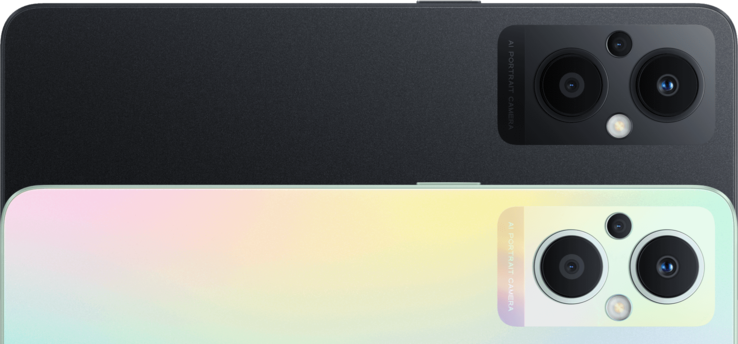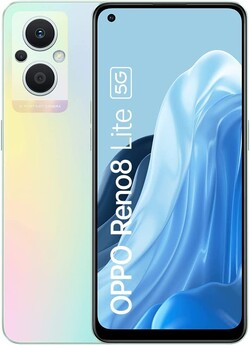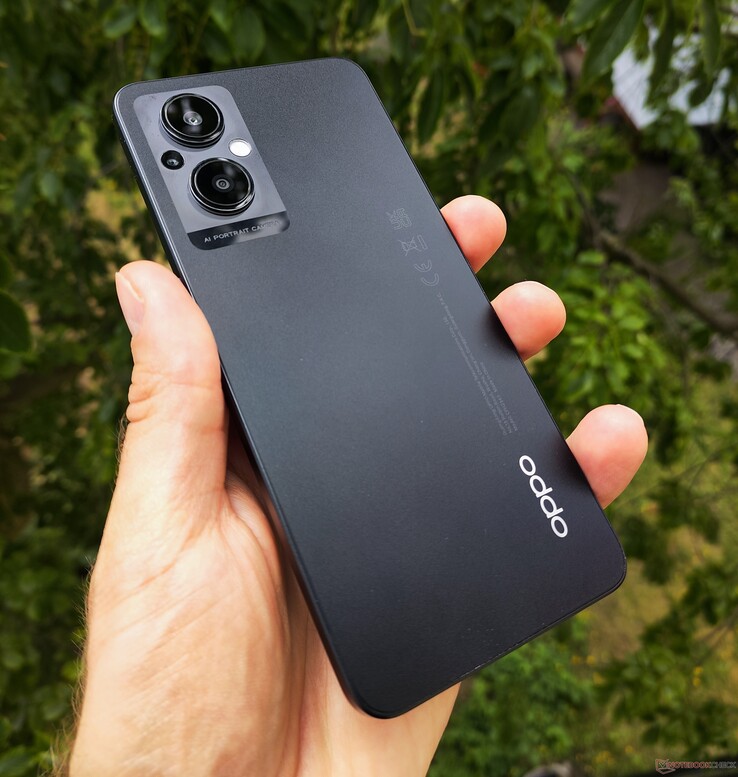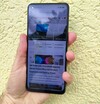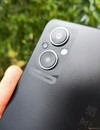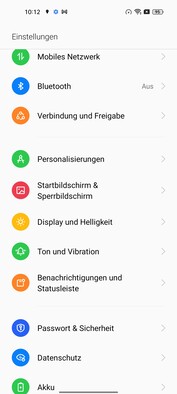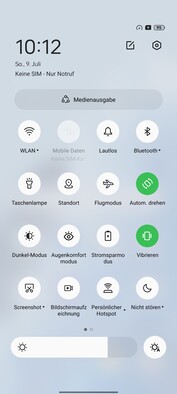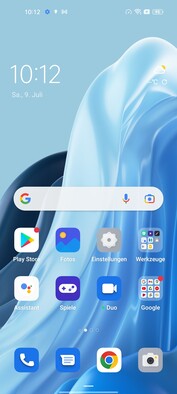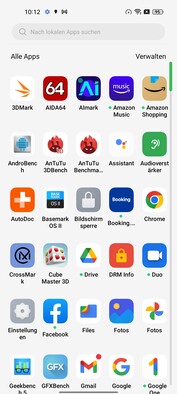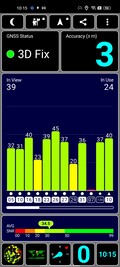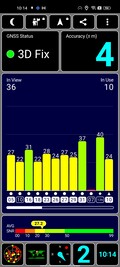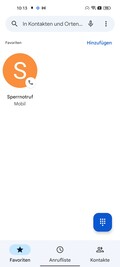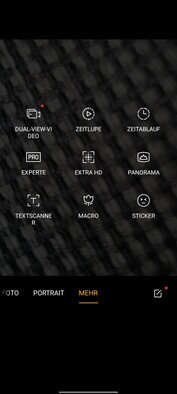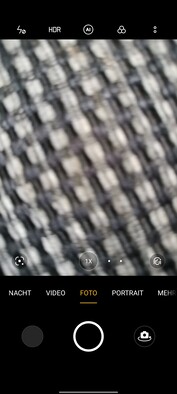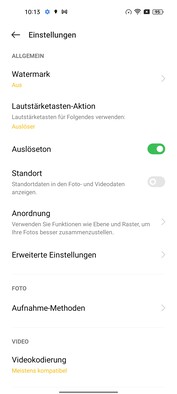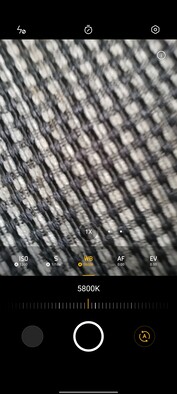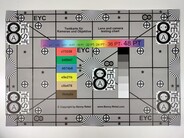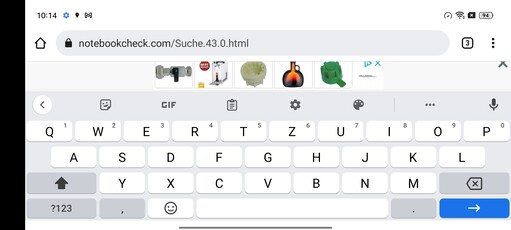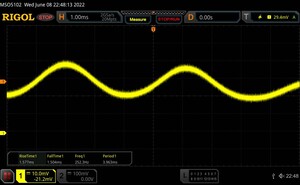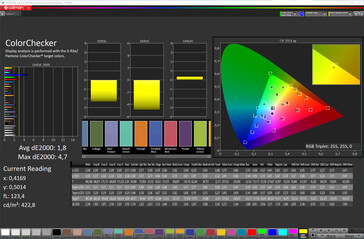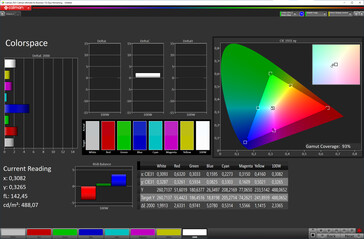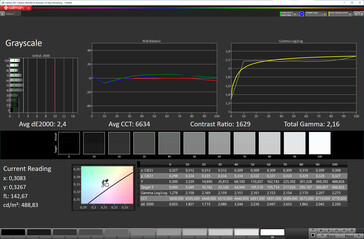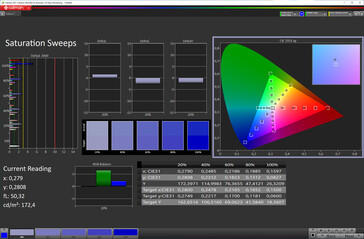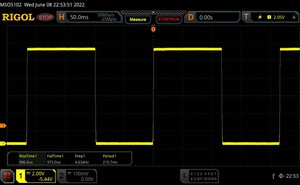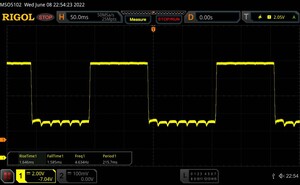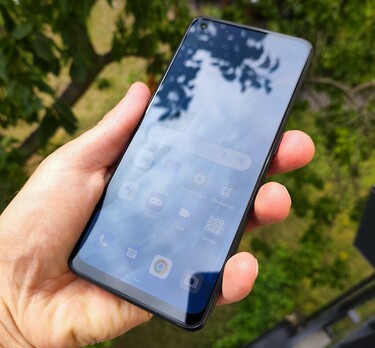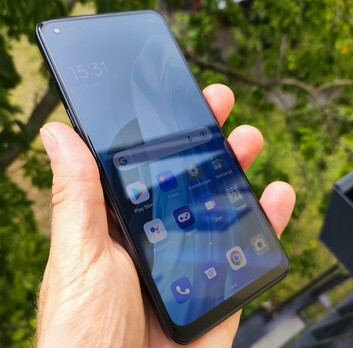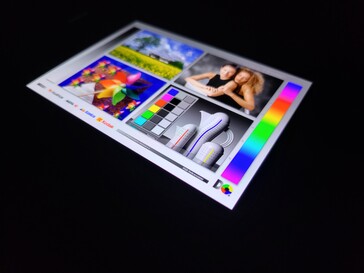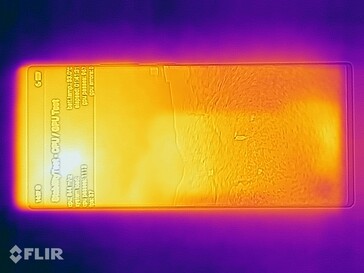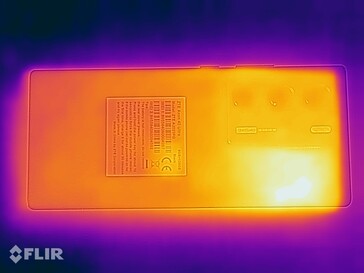Oppo Reno8 Lite 5G Review - Not enough for an upper mid-range smartphone
Besides the Find X5 Lite oppo takes the lead with the Reno8 Lite Oppo now adds another mid-range smartphone to its portfolio here, which, however, is not based on a MediaTek SoC but is based on the Snapdragon 695. It also has 8 GB of RAM and internal storage of 128 GB. Although the Reno8 Lite has an MSRP of 389 Euros, it only uses a 60 Hz AMOLED display and a mono speaker.
We will take a closer look at how Oppo's new mid-range device compares to the strong rivals in its price range in this review.
Possible competitors in comparison
Rating | Date | Model | Weight | Drive | Size | Resolution | Price |
|---|---|---|---|---|---|---|---|
| 82.4 % v7 (old) | 07 / 2022 | Oppo Reno8 Lite 5G SD 695 5G, Adreno 619 | 173 g | 128 GB UFS 2.2 Flash | 6.43" | 2400x1080 | |
| 83.2 % v7 (old) | 06 / 2022 | Samsung Galaxy A33 5G Exynos 1280, Mali-G68 MP4 | 186 g | 128 GB UFS 2.2 Flash | 6.40" | 2400x1080 | |
| 85.3 % v7 (old) | 02 / 2022 | Motorola Moto G200 5G SD 888+ 5G, Adreno 660 | 202 g | 128 GB UFS 3.1 Flash | 6.80" | 2460x1080 | |
| 81.7 % v7 (old) | 07 / 2022 | Motorola Moto G82 5G SD 695 5G, Adreno 619 | 173 g | 128 GB UFS 2.1 Flash | 6.60" | 2400x1080 | |
| 86 % v7 (old) | 05 / 2021 | Xiaomi Poco F3 SD 870, Adreno 650 | 196 g | 128 GB UFS 3.1 Flash | 6.67" | 2400x1080 |
Case - Oppo phone with IP rating
The Reno8 Lite 5G primarily wants to stand out from the mid-range competition with its striking design. Oppo's smartphone has a rectangular camera module with an LED ring around each of the two lenses. These "Orbit Lights" light up as soon as a new notification or calls are received in the colors electric blue, light blue, cyan blue, or baby blue. Besides our black version, Oppo also offers a variant with a color gradient called "Rainbow Spectrum", which is supposed to provide a particularly shiny effect depending on the incidence of light.
Besides these striking design elements, the Reno8 Lite has an IPX4 certification, so a walk in the rain should not be a problem with the sweat- and splash-proof casing. The build quality meets the requirements of an upper mid-range phone, but we cannot say the same for the haptics: the hand-feel of the plastic back and the plastic frame rather correspond to a 200-euro smartphone, and we also find the ergonomics a bit bulky due to the flat design of the back cover.
Equipment - Reno8 Lite 5G with 3.5 mm jack
The mid-range smartphone's features include an Always-On display function, a 3.5 mm jack, and USB OTG, which allows connecting peripherals via the USB-C port. The interface's data transfer follows the USB 2.0 standard. The capacity of the internal UFS storage is 128 GB, with about 110 GB reserved for the operating system and preinstalled apps. In addition, the internal UFS memory can be used for a virtual RAM expansion of the physical working memory by up to 5 GB.
microSD card reader
Memory cards with up to 1 TB can be installed into the microSD slot. We take a closer look at the memory slot's speed with our reference memory card AV PRO V60. Both the CPDT benchmark and our JPEG Copy test results attest to the Oppo phone's decent performance.
| SD Card Reader - average JPG Copy Test (av. of 3 runs) | |
| Samsung Galaxy A33 5G (Angelbird AV Pro V60) | |
| Oppo Reno8 Lite 5G (Angelbird AV Pro V60) | |
| Average of class Smartphone (5.72 - 58.9, n=69, last 2 years) | |
| Motorola Moto G82 5G (Angelbird V60) | |
Cross Platform Disk Test (CPDT)
Software - Oppo Phone with Android 11
The Chinese manufacturer still installs the now outdated Android 11 as the operating system, but with current security patches from May 2022 at the time of the test. Oppo superimposes its in-house ColorOS 12 UI with the new Air Gestures. However, scrolling through feeds via hand gestures currently only works with Facebook, Instagram, TikTok, and YouTube. We cannot find out if and when an update to Android 12 will be released. However, Oppo had also issued an update guarantee for the Reno series, according to which three-year security updates are to be provided quarterly for the Reno8 Lite as well.
Communication and GNSS - Oppo phone with WiFi 5
In terms of communication modules, Oppo relies on Bluetooth version 5.1 and an NFC chip for contactless payment. The integrated WLAN module only supports Wi-Fi 5, since the Snapdragon 695 does not support the 802.11ax standard. Nevertheless, solid transfer rates are possible in everyday use with the Reno8 Lite 5G and our reference router Asus ROG Rapture GT-AXE11000.
The Oppo smartphone accesses the mobile Internet via the fast 5G networks. However, the mid-range phone also supports all 4G frequencies relevant for the German-speaking region in terms of LTE bands.
| Networking | |
| iperf3 receive AXE11000 | |
| Average of class Smartphone (52 - 1857, n=183, last 2 years) | |
| Samsung Galaxy A33 5G | |
| Motorola Moto G82 5G | |
| Oppo Reno8 Lite 5G | |
| iperf3 transmit AXE11000 | |
| Average of class Smartphone (49.8 - 1828, n=183, last 2 years) | |
| Motorola Moto G82 5G | |
| Oppo Reno8 Lite 5G | |
| Samsung Galaxy A33 5G | |
| iperf3 transmit AX12 | |
| Xiaomi Poco F3 | |
| Motorola Moto G200 5G | |
| iperf3 receive AX12 | |
| Motorola Moto G200 5G | |
| Xiaomi Poco F3 | |
In order to be able to assess the tracking accuracy of the Reno8 Lite in practice, we record a route in parallel with the Garmin Venu 2 for comparison purposes. The deviations total only 50 meters at the end of the 10 km route. However, the detailed course reveals one or two inaccuracies of the Oppo phone, especially when changing directions. The GPS (L1), GLONASS, QZSS, Galileo (E1), and Beidou (B1) satellite networks are used for localization in the test.
Phone features and voice quality - Reno8 Lite 5G with Dual SIM
Cameras - Oppo Phone with "Triple-Cam"
The 16 MP camera on the front can capture nice but a bit too soft selfies in a lot of light. The triple camera module on the back consists of a 64 MP main camera plus a macro and telephoto lens for depth of field information. An ultra-wide-angle camera has not been installed in the Reno8 Lite. Videos can also only be recorded with a maximum of 1080p and at up to 30 fps.
Oppo does not reveal anything about the exact choice of the image sensor, but the mid-range phone can take high-quality pictures with a good color reproduction in daylight. However, the richness of detail in the photos is somewhat lost due to the often somewhat low image sharpness, especially in the peripheral areas. When it gets darker, the pictures suffer from image noise and blurriness. The illumination is also average for this price range.
Image comparison
Choose a scene and navigate within the first image. One click changes the position on touchscreens. One click on the zoomed-in image opens the original in a new window. The first image shows the scaled photograph of the test device.
Main cameraMain cameraLow Light5x Zoom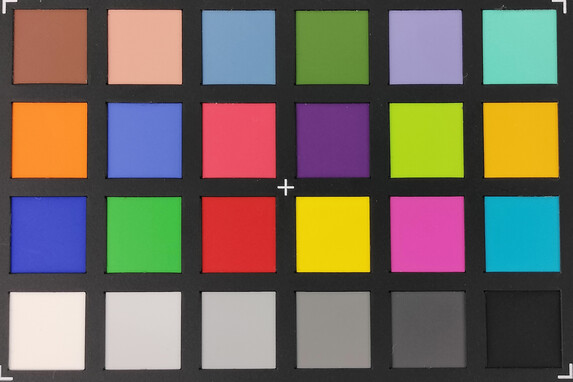

Accessories and warranty - Reno8 Lite 5G with power adapter
A fast charger is included, but only with 30 watts. Furthermore, a USB-C cable and a SIM tool as well as a protective cover are included in the scope of delivery.
Oppo grants a 24-month warranty in Germany for its smartphones.
Input devices & Handling - Oppo phone with FaceUnlock
Inputs on the 6.43-inch OLED screen are implemented accurately and quickly, but screen changes or scrolling are visibly less smooth than in the competition with a higher refresh rate. A sampling rate of 180 Hz is supported for special applications, such as games, so the touchscreen is polled 180 times per second.
The optical fingerprint scanner in the OLED panel recognizes the user reliably, but a bit slower than good sensors in the power button. Biometric authentication via 2D facial recognition using the front-facing camera is also supported.
Display - Oppo Phone with OLED
The OLED panel of the Oppo phone, with a refresh rate of 60 Hz, achieves a pixel density of about 400 PPI at a resolution of 2400 x 1080 pixels and a diagonal of 6.43 inches.
The Reno8 Lite uses PWM with a frequency of 116 to 252 Hz to regulate the luminance, at a brightness of below 48 percent - above that, we measure a constant 60 Hz. The maximum luminance of about 600 cd/m² in the peak that we measured is good, but nothing special in this price range. The same applies to the realistic APL18 test, which results in a maximum brightness of 802 cd/m².
| |||||||||||||||||||||||||
Brightness Distribution: 96 %
Center on Battery: 602 cd/m²
Contrast: ∞:1 (Black: 0 cd/m²)
ΔE ColorChecker Calman: 2 | ∀{0.5-29.43 Ø4.79}
ΔE Greyscale Calman: 3.7 | ∀{0.09-98 Ø5}
92.7% sRGB (Calman 2D)
Gamma: 2.26
CCT: 6996 K
| Oppo Reno8 Lite 5G OLED, 2400x1080, 6.4" | Samsung Galaxy A33 5G Super AMOLED, 2400x1080, 6.4" | Motorola Moto G200 5G IPS LCD, 2460x1080, 6.8" | Motorola Moto G82 5G OLED, 2400x1080, 6.6" | Xiaomi Poco F3 AMOLED, 2400x1080, 6.7" | |
|---|---|---|---|---|---|
| Screen | 28% | -21% | -19% | 47% | |
| Brightness middle (cd/m²) | 602 | 693 15% | 512 -15% | 635 5% | 889 48% |
| Brightness (cd/m²) | 599 | 695 16% | 488 -19% | 640 7% | 902 51% |
| Brightness Distribution (%) | 96 | 98 2% | 87 -9% | 96 0% | 95 -1% |
| Black Level * (cd/m²) | 0.36 | ||||
| Colorchecker dE 2000 * | 2 | 1.3 35% | 3.42 -71% | 2.96 -48% | 0.9 55% |
| Colorchecker dE 2000 max. * | 5.2 | 3.5 33% | 5.9 -13% | 7.63 -47% | 1.9 63% |
| Greyscale dE 2000 * | 3.7 | 1.3 65% | 3.7 -0% | 4.8 -30% | 1.3 65% |
| Gamma | 2.26 97% | 2.14 103% | 7154 0% | 2.214 99% | 2.26 97% |
| CCT | 6996 93% | 6530 100% | 1.944 334362% | 6970 93% | 6614 98% |
| Contrast (:1) | 1422 |
* ... smaller is better
Screen Flickering / PWM (Pulse-Width Modulation)
| Screen flickering / PWM detected | 252.3 Hz | ||
The display backlight flickers at 252.3 Hz (worst case, e.g., utilizing PWM) . The frequency of 252.3 Hz is relatively high, so most users sensitive to PWM should not notice any flickering. However, there are reports that some users are still sensitive to PWM at 500 Hz and above, so be aware. In comparison: 53 % of all tested devices do not use PWM to dim the display. If PWM was detected, an average of 8152 (minimum: 5 - maximum: 343500) Hz was measured. | |||
Measurements at a fixed zoom level and various brightness settings
The display color analysis is performed with the help of a photospectrometer and the CalMAN software. The deviations in the color representation are low, but the grayscale is not optimally calibrated. Especially blue tones are not the Reno8 Lite's strength with a deltaE of over 5.
Display Response Times
| ↔ Response Time Black to White | ||
|---|---|---|
| 1.97 ms ... rise ↗ and fall ↘ combined | ↗ 0.996 ms rise | |
| ↘ 0.973 ms fall | ||
| The screen shows very fast response rates in our tests and should be very well suited for fast-paced gaming. In comparison, all tested devices range from 0.1 (minimum) to 240 (maximum) ms. » 9 % of all devices are better. This means that the measured response time is better than the average of all tested devices (20.3 ms). | ||
| ↔ Response Time 50% Grey to 80% Grey | ||
| 3.23 ms ... rise ↗ and fall ↘ combined | ↗ 1.646 ms rise | |
| ↘ 1.585 ms fall | ||
| The screen shows very fast response rates in our tests and should be very well suited for fast-paced gaming. In comparison, all tested devices range from 0.165 (minimum) to 636 (maximum) ms. » 12 % of all devices are better. This means that the measured response time is better than the average of all tested devices (31.7 ms). | ||
Performance - Reno8 Lite 5G with Qualcomm SoC
The Reno8 Lite 5G is equipped with a Qualcomm Snapdragon 695 integrates an Adreno 619 as the graphics unit and offers an appealing system speed. In the benchmarks, the Oppo smartphone performs on par with a Moto G82 which is also based on the same Qualcomm SoC. However, the Reno8 Lite 5G does not stand a chance against powerful mid-range devices. Even an Exynos 1280 in the Galaxy A33 is sometimes much better. The speed of the installed UFS memory is also rather below average for the price, but this can be attributed to the low memory bandwidth of the Snapdragon 695.
| CrossMark - Overall | |
| Average of class Smartphone (187 - 2674, n=131, last 2 years) | |
| Oppo Reno8 Lite 5G | |
| Average Qualcomm Snapdragon 695 5G (521 - 606, n=18) | |
| Motorola Moto G82 5G | |
| AImark - Score v2.x | |
| Motorola Moto G200 5G | |
| Xiaomi Poco F3 | |
| Average Qualcomm Snapdragon 695 5G (4924 - 5839, n=10) | |
| Oppo Reno8 Lite 5G | |
| Samsung Galaxy A33 5G | |
| Motorola Moto G82 5G | |
GFXBench (DX / GLBenchmark) 2.7: T-Rex Onscreen | 1920x1080 T-Rex Offscreen
GFXBench 3.0: on screen Manhattan Onscreen OGL | 1920x1080 1080p Manhattan Offscreen
GFXBench 3.1: on screen Manhattan ES 3.1 Onscreen | 1920x1080 Manhattan ES 3.1 Offscreen
GFXBench: on screen Car Chase Onscreen | 1920x1080 Car Chase Offscreen | on screen Aztec Ruins High Tier Onscreen | 2560x1440 Aztec Ruins High Tier Offscreen | on screen Aztec Ruins Normal Tier Onscreen | 1920x1080 Aztec Ruins Normal Tier Offscreen
| 3DMark / Wild Life Extreme Unlimited (sort by value) | |
| Oppo Reno8 Lite 5G | |
| Samsung Galaxy A33 5G | |
| Motorola Moto G200 5G | |
| Motorola Moto G82 5G | |
| Xiaomi Poco F3 | |
| 3DMark / Wild Life Extreme (sort by value) | |
| Oppo Reno8 Lite 5G | |
| Samsung Galaxy A33 5G | |
| Motorola Moto G200 5G | |
| Motorola Moto G82 5G | |
| Xiaomi Poco F3 | |
| 3DMark / Wild Life Unlimited Score (sort by value) | |
| Oppo Reno8 Lite 5G | |
| Samsung Galaxy A33 5G | |
| Motorola Moto G200 5G | |
| Motorola Moto G82 5G | |
| Xiaomi Poco F3 | |
| 3DMark / Wild Life Score (sort by value) | |
| Oppo Reno8 Lite 5G | |
| Samsung Galaxy A33 5G | |
| Motorola Moto G200 5G | |
| Motorola Moto G82 5G | |
| Xiaomi Poco F3 | |
| 3DMark / Sling Shot Extreme (Vulkan) Unlimited Physics (sort by value) | |
| Oppo Reno8 Lite 5G | |
| Samsung Galaxy A33 5G | |
| Motorola Moto G82 5G | |
| 3DMark / Sling Shot Extreme (Vulkan) Unlimited Graphics (sort by value) | |
| Oppo Reno8 Lite 5G | |
| Samsung Galaxy A33 5G | |
| Motorola Moto G82 5G | |
| 3DMark / Sling Shot Extreme (Vulkan) Unlimited (sort by value) | |
| Oppo Reno8 Lite 5G | |
| Samsung Galaxy A33 5G | |
| Motorola Moto G82 5G | |
| 3DMark / Sling Shot Extreme (ES 3.1) Unlimited Physics (sort by value) | |
| Oppo Reno8 Lite 5G | |
| Samsung Galaxy A33 5G | |
| Motorola Moto G200 5G | |
| Motorola Moto G82 5G | |
| Xiaomi Poco F3 | |
| 3DMark / Sling Shot Extreme (ES 3.1) Unlimited Graphics (sort by value) | |
| Oppo Reno8 Lite 5G | |
| Samsung Galaxy A33 5G | |
| Motorola Moto G200 5G | |
| Motorola Moto G82 5G | |
| Xiaomi Poco F3 | |
| 3DMark / Sling Shot Extreme (ES 3.1) Unlimited (sort by value) | |
| Oppo Reno8 Lite 5G | |
| Samsung Galaxy A33 5G | |
| Motorola Moto G200 5G | |
| Motorola Moto G82 5G | |
| Xiaomi Poco F3 | |
| 3DMark / Sling Shot OpenGL ES 3.0 Physics (sort by value) | |
| Oppo Reno8 Lite 5G | |
| Samsung Galaxy A33 5G | |
| Motorola Moto G82 5G | |
| 3DMark / Sling Shot OpenGL ES 3.0 Graphics (sort by value) | |
| Oppo Reno8 Lite 5G | |
| Samsung Galaxy A33 5G | |
| Motorola Moto G82 5G | |
| 3DMark / Sling Shot OpenGL ES 3.0 (sort by value) | |
| Oppo Reno8 Lite 5G | |
| Samsung Galaxy A33 5G | |
| Motorola Moto G82 5G | |
| 3DMark / Sling Shot Extreme (ES 3.1) (sort by value) | |
| Oppo Reno8 Lite 5G | |
| Samsung Galaxy A33 5G | |
| Motorola Moto G82 5G | |
| 3DMark / Sling Shot Extreme (ES 3.1) Graphics (sort by value) | |
| Oppo Reno8 Lite 5G | |
| Samsung Galaxy A33 5G | |
| Motorola Moto G82 5G | |
| 3DMark / Sling Shot Extreme (ES 3.1) Physics (sort by value) | |
| Oppo Reno8 Lite 5G | |
| Samsung Galaxy A33 5G | |
| Motorola Moto G82 5G | |
| 3DMark / Sling Shot OpenGL ES 3.0 Unlimited (sort by value) | |
| Oppo Reno8 Lite 5G | |
| Samsung Galaxy A33 5G | |
| Motorola Moto G82 5G | |
| Xiaomi Poco F3 | |
| 3DMark / Sling Shot OpenGL ES 3.0 Unlimited Graphics (sort by value) | |
| Oppo Reno8 Lite 5G | |
| Samsung Galaxy A33 5G | |
| Motorola Moto G82 5G | |
| Xiaomi Poco F3 | |
| 3DMark / Sling Shot OpenGL ES 3.0 Unlimited Physics (sort by value) | |
| Oppo Reno8 Lite 5G | |
| Samsung Galaxy A33 5G | |
| Motorola Moto G82 5G | |
| Xiaomi Poco F3 | |
| GFXBench (DX / GLBenchmark) 2.7 / T-Rex Onscreen (sort by value) | |
| Oppo Reno8 Lite 5G | |
| Samsung Galaxy A33 5G | |
| Motorola Moto G200 5G | |
| Motorola Moto G82 5G | |
| Xiaomi Poco F3 | |
| GFXBench (DX / GLBenchmark) 2.7 / T-Rex Offscreen (sort by value) | |
| Oppo Reno8 Lite 5G | |
| Samsung Galaxy A33 5G | |
| Motorola Moto G200 5G | |
| Motorola Moto G82 5G | |
| Xiaomi Poco F3 | |
| GFXBench 3.0 / Manhattan Onscreen OGL (sort by value) | |
| Oppo Reno8 Lite 5G | |
| Samsung Galaxy A33 5G | |
| Motorola Moto G200 5G | |
| Motorola Moto G82 5G | |
| Xiaomi Poco F3 | |
| GFXBench 3.0 / 1080p Manhattan Offscreen (sort by value) | |
| Oppo Reno8 Lite 5G | |
| Samsung Galaxy A33 5G | |
| Motorola Moto G200 5G | |
| Motorola Moto G82 5G | |
| Xiaomi Poco F3 | |
| GFXBench 3.1 / Manhattan ES 3.1 Onscreen (sort by value) | |
| Oppo Reno8 Lite 5G | |
| Samsung Galaxy A33 5G | |
| Motorola Moto G200 5G | |
| Motorola Moto G82 5G | |
| Xiaomi Poco F3 | |
| GFXBench 3.1 / Manhattan ES 3.1 Offscreen (sort by value) | |
| Oppo Reno8 Lite 5G | |
| Samsung Galaxy A33 5G | |
| Motorola Moto G200 5G | |
| Motorola Moto G82 5G | |
| Xiaomi Poco F3 | |
| GFXBench / Car Chase Onscreen (sort by value) | |
| Oppo Reno8 Lite 5G | |
| Samsung Galaxy A33 5G | |
| Motorola Moto G200 5G | |
| Motorola Moto G82 5G | |
| Xiaomi Poco F3 | |
| GFXBench / Car Chase Offscreen (sort by value) | |
| Oppo Reno8 Lite 5G | |
| Samsung Galaxy A33 5G | |
| Motorola Moto G200 5G | |
| Motorola Moto G82 5G | |
| Xiaomi Poco F3 | |
| GFXBench / Aztec Ruins High Tier Onscreen (sort by value) | |
| Oppo Reno8 Lite 5G | |
| Samsung Galaxy A33 5G | |
| Motorola Moto G200 5G | |
| Motorola Moto G82 5G | |
| Xiaomi Poco F3 | |
| GFXBench / Aztec Ruins High Tier Offscreen (sort by value) | |
| Oppo Reno8 Lite 5G | |
| Samsung Galaxy A33 5G | |
| Motorola Moto G200 5G | |
| Motorola Moto G82 5G | |
| Xiaomi Poco F3 | |
| GFXBench / Aztec Ruins Normal Tier Onscreen (sort by value) | |
| Oppo Reno8 Lite 5G | |
| Samsung Galaxy A33 5G | |
| Motorola Moto G200 5G | |
| Motorola Moto G82 5G | |
| Xiaomi Poco F3 | |
| GFXBench / Aztec Ruins Normal Tier Offscreen (sort by value) | |
| Oppo Reno8 Lite 5G | |
| Samsung Galaxy A33 5G | |
| Motorola Moto G200 5G | |
| Motorola Moto G82 5G | |
| Xiaomi Poco F3 | |
| Jetstream 2 - 2.0 Total Score | |
| Average of class Smartphone (23.8 - 387, n=155, last 2 years) | |
| Motorola Moto G200 5G (Chrome97) | |
| Xiaomi Poco F3 (Chrome 90) | |
| Average Qualcomm Snapdragon 695 5G (48.6 - 105.3, n=19) | |
| Samsung Galaxy A33 5G (Chrome) | |
| Motorola Moto G82 5G (Chrome 102) | |
| Oppo Reno8 Lite 5G (Chrome 103) | |
| WebXPRT 3 - Overall | |
| Average of class Smartphone (38 - 380, n=40, last 2 years) | |
| Motorola Moto G200 5G (Chrome97) | |
| Xiaomi Poco F3 (Chrome 90) | |
| Oppo Reno8 Lite 5G (Chrome 103) | |
| Average Qualcomm Snapdragon 695 5G (75 - 156, n=12) | |
| Samsung Galaxy A33 5G (Chrome 102.0.5005.99) | |
| Motorola Moto G82 5G (Chrome 102) | |
| Octane V2 - Total Score | |
| Average of class Smartphone (2228 - 121337, n=202, last 2 years) | |
| Motorola Moto G200 5G (Chrome97) | |
| Xiaomi Poco F3 (Chrome 90) | |
| Samsung Galaxy A33 5G (Chrome 102.0.5005.99) | |
| Average Qualcomm Snapdragon 695 5G (17849 - 31647, n=21) | |
| Motorola Moto G82 5G (Chrome 102) | |
| Oppo Reno8 Lite 5G (Chrome 103) | |
| Mozilla Kraken 1.1 - Total | |
| Oppo Reno8 Lite 5G (Chrome 103) | |
| Motorola Moto G82 5G (Chrome 102) | |
| Samsung Galaxy A33 5G (Chrome) | |
| Average Qualcomm Snapdragon 695 5G (1298 - 2501, n=18) | |
| Xiaomi Poco F3 (Chrome 90) | |
| Motorola Moto G200 5G (Chrome97) | |
| Average of class Smartphone (257 - 28190, n=157, last 2 years) | |
* ... smaller is better
| Oppo Reno8 Lite 5G | Samsung Galaxy A33 5G | Motorola Moto G200 5G | Motorola Moto G82 5G | Xiaomi Poco F3 | Average 128 GB UFS 2.2 Flash | Average of class Smartphone | |
|---|---|---|---|---|---|---|---|
| AndroBench 3-5 | 22% | 117% | 5% | 71% | 31% | 220% | |
| Sequential Read 256KB (MB/s) | 498.54 | 512.84 3% | 1898 281% | 473.4 -5% | 1378 176% | 736 ? 48% | 2202 ? 342% |
| Sequential Write 256KB (MB/s) | 438.49 | 487.66 11% | 712 62% | 445.7 2% | 684 56% | 532 ? 21% | 1819 ? 315% |
| Random Read 4KB (MB/s) | 155.32 | 216.48 39% | 155.9 0% | 180.8 16% | 208 34% | 193 ? 24% | 292 ? 88% |
| Random Write 4KB (MB/s) | 143.54 | 194.12 35% | 322.5 125% | 155.5 8% | 170.6 19% | 186.3 ? 30% | 334 ? 133% |
Emissions - Oppo smartphone stays cool
Temperature
The casing barely heats up in everyday use even under load. The waste heat inside the Reno8 Lite 5G does not reduce the performance in our test. The two stress tests of 3DMark run without problems with over 99 percent mark.
(+) The maximum temperature on the upper side is 33.3 °C / 92 F, compared to the average of 35.2 °C / 95 F, ranging from 21.9 to 247 °C for the class Smartphone.
(+) The bottom heats up to a maximum of 33 °C / 91 F, compared to the average of 34 °C / 93 F
(+) In idle usage, the average temperature for the upper side is 26.6 °C / 80 F, compared to the device average of 32.9 °C / 91 F.
3DMark Wild Life Stress Test
| 3DMark | |
| Wild Life Stress Test Stability | |
| Samsung Galaxy A33 5G | |
| Motorola Moto G82 5G | |
| Oppo Reno8 Lite 5G | |
| Xiaomi Poco F3 | |
| Motorola Moto G200 5G | |
| Wild Life Extreme Stress Test | |
| Samsung Galaxy A33 5G | |
| Motorola Moto G82 5G | |
| Oppo Reno8 Lite 5G | |
| Xiaomi Poco F3 | |
| Motorola Moto G200 5G | |
Speaker
Oppo only installs a mono speaker in its mid-range phone, but it can get very loud with over 92 dB and enables a linear reproduction. A low-noise 3.5 mm jack (SNR: 99.4 dBFS) can also be used for a stereo sound experience. Alternatively, Bluetooth 5.1 is available for wireless headphones.
Oppo Reno8 Lite 5G audio analysis
(+) | speakers can play relatively loud (92.1 dB)
Bass 100 - 315 Hz
(-) | nearly no bass - on average 25.4% lower than median
(+) | bass is linear (5.5% delta to prev. frequency)
Mids 400 - 2000 Hz
(+) | balanced mids - only 4.5% away from median
(+) | mids are linear (4.4% delta to prev. frequency)
Highs 2 - 16 kHz
(+) | balanced highs - only 4.7% away from median
(+) | highs are linear (4.1% delta to prev. frequency)
Overall 100 - 16.000 Hz
(±) | linearity of overall sound is average (16.8% difference to median)
Compared to same class
» 8% of all tested devices in this class were better, 7% similar, 85% worse
» The best had a delta of 11%, average was 35%, worst was 134%
Compared to all devices tested
» 28% of all tested devices were better, 7% similar, 64% worse
» The best had a delta of 4%, average was 24%, worst was 134%
Motorola Moto G82 5G audio analysis
(+) | speakers can play relatively loud (82.9 dB)
Bass 100 - 315 Hz
(-) | nearly no bass - on average 26.3% lower than median
(±) | linearity of bass is average (8.8% delta to prev. frequency)
Mids 400 - 2000 Hz
(±) | higher mids - on average 5.1% higher than median
(+) | mids are linear (6.2% delta to prev. frequency)
Highs 2 - 16 kHz
(+) | balanced highs - only 4.3% away from median
(+) | highs are linear (5.3% delta to prev. frequency)
Overall 100 - 16.000 Hz
(±) | linearity of overall sound is average (20% difference to median)
Compared to same class
» 31% of all tested devices in this class were better, 9% similar, 60% worse
» The best had a delta of 11%, average was 35%, worst was 134%
Compared to all devices tested
» 50% of all tested devices were better, 8% similar, 42% worse
» The best had a delta of 4%, average was 24%, worst was 134%
Battery life - Reno8 Lite 5G with 4,500 mAh
Energy consumption
With the 33W SUPERVOOC fast charging technology, a full battery charge takes about 70 minutes; wireless charging is not supported. The Reno8 Lite's power consumption under load is very low.
| Off / Standby | |
| Idle | |
| Load |
|
Key:
min: | |
| Oppo Reno8 Lite 5G 4500 mAh | Samsung Galaxy A33 5G 5000 mAh | Motorola Moto G200 5G 5000 mAh | Motorola Moto G82 5G 5000 mAh | Xiaomi Poco F3 4520 mAh | Average Qualcomm Snapdragon 695 5G | Average of class Smartphone | |
|---|---|---|---|---|---|---|---|
| Power Consumption | -34% | -39% | -7% | -32% | -26% | -67% | |
| Idle Minimum * (Watt) | 0.69 | 0.88 -28% | 0.6 13% | 0.9 -30% | 0.76 -10% | 0.886 ? -28% | 0.851 ? -23% |
| Idle Average * (Watt) | 1.58 | 1.47 7% | 0.9 43% | 1.2 24% | 1.29 18% | 1.76 ? -11% | 1.431 ? 9% |
| Idle Maximum * (Watt) | 1.6 | 1.52 5% | 1.5 6% | 1.4 12% | 1.45 9% | 1.92 ? -20% | 1.61 ? -1% |
| Load Average * (Watt) | 2.59 | 5.38 -108% | 7 -170% | 3.3 -27% | 4.6 -78% | 3.86 ? -49% | 7.08 ? -173% |
| Load Maximum * (Watt) | 4.47 | 6.62 -48% | 8.4 -88% | 5.2 -16% | 8.87 -98% | 5.45 ? -22% | 11.1 ? -148% |
* ... smaller is better
Power Consumption: Geekbench (150 nits)
Power Consumption: GFXBench (150 nits)
Battery life
In our WLAN test with an adjusted display brightness of 150 cd/m², Oppo's phone lasted over 15 hours, which is a solid rate in relation to the 60 Hz panel.
| Oppo Reno8 Lite 5G 4500 mAh | Samsung Galaxy A33 5G 5000 mAh | Motorola Moto G200 5G 5000 mAh | Motorola Moto G82 5G 5000 mAh | Xiaomi Poco F3 4520 mAh | |
|---|---|---|---|---|---|
| Battery runtime | |||||
| WiFi v1.3 (h) | 15.1 | 12.9 -15% | 15.1 0% | 17 13% | 13.4 -11% |
Pros
Cons
Verdict
We cannot give the Oppo Reno8 Lite 5G a recommendation in view of the many shortcomings compared with the competition. Apart from the nice-looking design including dual ring lights, Oppo's smartphone lacks many features that would justify an MSRP of almost 400 Euros. Buyers in these price ranges can expect stereo speakers, an ultra-wide-angle lens, a panel with a frequency beyond 60 Hz, a better feel, or a more powerful chipset, among other things. Oppo does not exactly cover itself with glory in terms of software with the outdated Android 11. However, the Reno8 Lite could still positively appeal to one or the other user due to its quite compact and light build.
In order for the Reno8 Lite to be competitive, it has to be priced in line with the comparable low-cost mid-range, such as the Moto G52 or Redmi Note 11.
In the price segment around 300 Euros, we recommend our review of the Samsung Galaxy A33 or also Poco F3. If you can do without the 5G standard, you will find a good alternative with the Redmi Note 11 is a comparable total package for just half the price of a Reno8 Lite 5G.
Price and availability
The Oppo Reno8 Lite is available for a recommended retail price of 389 Euros, among others at amazon.de, available.
Oppo Reno8 Lite 5G
- 08/30/2022 v7 (old)
Marcus Herbrich




